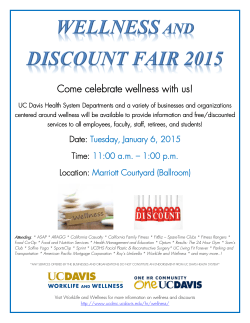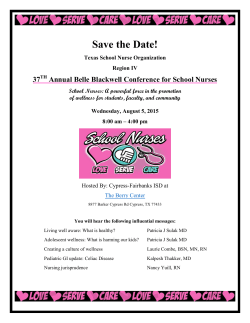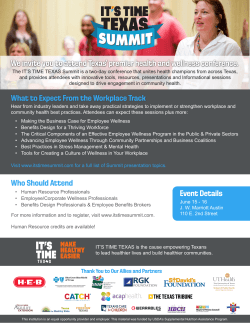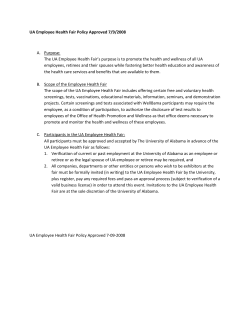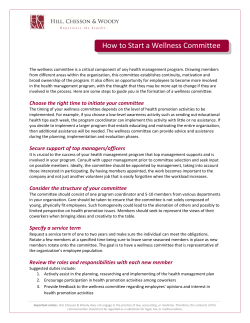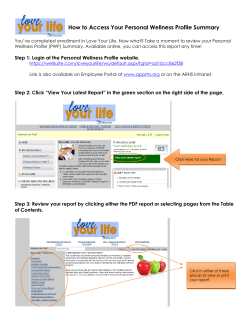
overcoming depression, mental illness stigma
John Shuchart Authors Humorous Book on Protect Yourself Against SKIN CANCER This Summer TESTOSTERONE A Man's Most Vital Hormone Clinical Research Trials The BUILDING BLOCKS of MEDICINE THE TEXAS TENORS Give Back PERFORMING IN KC! OVERCOMING DEPRESSION, Fighting the MENTAL ILLNESS STIGMA www.kchealthandwellness.com www.kchealthandwellness.com www.kchealthandwellness.com contents 6 Testosterone. A Man’s Most Vital Hormone. June 2015 20 8 The Texas Tenors Live In Concert 21 10 23 Benefiting The Mission Project and First Downs For Down Syndrome 11 12 15 16 18 Discharge Planners Are Patients Getting The Best Referrals? Clinical Research Trials The Building Blocks of Medicine Protect Yourself Against Skin Cancer This Summer Ingrown Toenails Causes and Treatments Humor Helps Author Overcome Depression and Fight Stigma Associated with Mental Illness Dr. Matt Daggett, Trained by Some of the World's Top Experts, Brings the Newest Orthopedic Shoulder and Knee Procedures Home to Kansas City 24 26 27 28 30 31 Traumatic Dental Injuries in Children The Tyramine / Headache Connection Helping Clients Win Social Security Disability Cases Men's Health FACTS For Men's Health Month Summer Goal Setting Volunteer Drivers Needed to Transport Cancer Patients to Treatment The Just for Her Event is getting BIGGER and BETTER in 2015! Our Father Follow the Leader www.kchealthandwellness.com 6 Health & Wellness J u n e 2 0 15 – K a n s a s C i t y June is Men's Health Month Testosterone A Man’s Most Vital Hormone By Sandy Edwards, APRN T estosterone is a man’s most vital hormone and is critical to overall health and well-being. Every man experiences a gradual decline in hormone production as he gets older. Beginning at age 30, his body starts to manufacture less and less testosterone, losing roughly one to three percent per year. Then, sometime between age 40 and 55, testosterone levels drop dramatically and signal the onset of Andropause, the medical term for the male equivalent of Menopause. Throughout this process, men find themselves putting on weight, losing muscle mass, feeling sluggish, feeling depressed and becoming increasingly irritable. They remember a time when they had energy for work and family, but those days are now few and far between. They find it harder to concentrate at work and their workouts are cut short by pain or fatigue that didn’t previously exist. The realization is even more troubling for those men who begin to experience lack of sexual drive and impotence. If the root problem, hormonal imbalance, is not treated properly men can experience a number of physical and mental challenges. Treating Low Testosterone with BIO-IDENTICAL HORMONE REPLACEMENT (FAQ’S) Q: What is a bio-identical hormone replacement therapy? A: Bio-identical hormones are the same as those produced by the human body. They are not synthetic or replicas. At Mirabile M.D., we use SottoPelle, a bio-identical hormone pellet therapy, for the treatment of low testosterone in men. Pellets are derived from wild yam and other natural plant-based ingredients. They are hand formulated in compounding pharmacies and possess the exact hormonal structure of the human hormones. Pellets, once implanted, work automatically. The hormones are secreted in tiny amounts into the blood stream daily. When more hormones are needed due to stress or exercise, the body will respond and deliver more. No other form of hormone delivery, whether capsules, pills, creams, or patches can produce the consistent blood level of testosterone that pellets can. www.kchealthandwellness.com K a n s a s C i t y – J u n e 2 0 15 Health & Wellness 7 Sandy Edwards, APRN Q: Why SottoPelle®? A: SottoPelle founder, Dr. Gino Tutera, is recog- nized worldwide as a pioneer and leader in the field of bio-identical hormone replacement therapy. Made by a highly-respected pharmacy, the precision process used results in superior quality pellets every time; pellets that can perform reliably week after week, month after month. This ensures that each patient receives the full benefit of a steady, accurate dose. Q: What is the difference between pellets and testosterone shots? A: Pellets work with the brain to regulate hor- mones. Pellet therapy is the only method of hormone therapy that gives sustained and consistent testosterone levels throughout the day without any “roller coaster” effect. Other forms of therapy simply cannot deliver such a steady state of hormone levels. Also, the pellet is placed in the subcutaneous fat, it is not metabolized by the inside GI tract, liver or kidneys and any extra breakdown by the organs. Pellets are released through the capillaries to match up with the hormone levels in your brain and are released as needed. Q: Why Mirabile M.D.? A: At Mirabile M.D., we are experts in the field of bio-identical hormone replacement therapy. Our owner and on-site physician, James Mirabile, MD, has over 20 years of experience treating women for hormonal imbalance. Dr. Mirabile and his team saw a need for men experiencing low testosterone. After much evaluation and research, Dr. Mirabile selected SottoPelle as the bio-identical hormone replacement therapy for both male and female patients. Sandy Edwards, APRN, started her undergraduate education at Kansas State University then transferred to Washburn University in Topeka where she became an RN with her BSN. She received her MSN at University of Missouri Kansas City (UMKC) in nursing education in 2002. She served as a Nursing Professor at UMKC and Johnson County Community College. In 2007, Sandy completed her Family Nurse Practitioner training at the University of Kansas Medical Center, and then passed her certification boards as a Family Nurse Practitioner. Sandy spent many years as an RN 1st assistant in gynecology, cardiac and neuro surgery. In 2012, Sandy began working in bio-identical hormone pellet therapy. She received training on various pellet therapy treatments, including SottoPelle. Sandy joined Dr. Mirabile’s hormone therapy team in 2013. Sandy enjoys helping her pellet therapy patients return to a hormonal balance. 4550 West 109th Street, Suite 130 Overland Park, KS 66211 913-888-7546 www.MirabileMD.com Mirabile M.D. combines Medi-Weightloss, MedCosmetic, Gynecology and Bio-Identical Hormone Replacement Therapy. Under the ownership of trusted physician, James Mirabile, MD, we are your one-stop shop for total wellness. www.kchealthandwellness.com 8 Health & Wellness J u n e 2 0 15 – K a n s a s C i t y THE TEXAS TENORS liVE iN cONcERT bENEfiTiNG THE miSSiON pROjEcT and fiRST dOwNS fOR dOwN SyNdROmE JUNE 13, 2015 at 7:30 PM Arvest bank Theatre At The midland THE TEXAS TENORS ARE EXciTEd TO ANNOuNcE THEiR RETuRN TO KANSAS ciTy TO pERfORm A SpEciAl bENEfiT cONcERT fOR THE miSSiON pROjEcT ANd fiRST dOwNS fOR dOwN SyNdROmE. Named #10 Classical Artist in the World With their Emmy Award winning PBS special now airing across the country, and Billboard chart topping albums, it's easy to see why The Texas Tenors have become America's favorite tenors. Since their whirlwind debut six years ago on NBC's America's Got Talent, The Texas Tenors have performed more than 800 concerts around the world, including a 24-city tour in the United Kingdom, Shanghai, China and collaborations with some of the most prestigious symphonies, performing arts centers and arenas in the United States. People are clearly enjoying their talent as they were recently named the #10 Classical Artist in the world for 2014 according to Billboard magazine. A Special Connection with The Mission Project The Texas Tenors first connected with The Mission Project in 2011 through founding member JC Fisher and his audiologist Dr. James Wise of Associated Audiologists. Dr. Wise’s son Ben has Down Syndrome and is a participant with The Mission Project. JC immediately felt a special connection with the organization as his uncle (also named Ben) had Down Syndrome. The Texas Tenors performed their first benefit concert for The Mission Project that year at the grand opening of the Kauffmann Center and continue to support and promote the work of The Mission Project. www.kchealthandwellness.com The Mission Project continues its great work and vision enabling capable adults with developmental or cognitive disabilities to live independently and safely in their communities with minimal support. • People with Down syndrome attend school, work, participate in decisions that affect them, and contribute to society in many ways. Through many generous donations, The Mission Project has been able to hire an executive director, who is also a licensed Occupational Therapist, enabling the organization to take the programming to higher heights. • All people with Down syndrome experience cognitive delays, but the effect is usually mild to moderate and is not indicative of the many strengths and talents that each individual possesses. “In addition to our transportation program that gets all of our participants to their jobs five minutes before their shift and picked up immediately at the end of their shift, we have been able to provide innovative programs that teach skills in the areas of healthy living, technology, socialization, and daily life independence. We have also been able to expand our reach to accept new participants into our community and help families in other parts of the KC metro area to connect with one another and start-up communities of their own. 2015 has been a significant year for growth for our organization, as we have created new community partnerships and built a volunteer program that has significantly improved the quality and effectiveness of our programs,” says Executive Director of The Mission Project, Sarah Mai. Down Syndrome Facts: • Down syndrome occurs when an individual has three, rather than two, copies of the 21st chromosome. This additional genetic material alters the course of development and causes the characteristics associated with Down syndrome. • Down syndrome is the most commonly occurring chromosomal condition; one in every 691 babies in the United States is born with Down syndrome. • There are more than 400,000 people living with Down syndrome in the United States. • Down syndrome occurs in people of all races and economic levels. • The incidence of births of children with Down syndrome increases with the age of the mother, but due to higher fertility rates in younger women, 80 percent of children with Down syndrome are born to women under 35 years of age. • People with Down syndrome have an increased risk for certain medical conditions such as congenital heart defects, respiratory and hearing problems, Alzheimer's disease, childhood leukemia, and thyroid conditions. Many of these conditions are now treatable, so most people with Down syndrome lead healthy lives. • A few of the common physical traits of Down syndrome are low muscle tone, small stature, an upward slant to the eyes, and a single deep crease across the center of the palm. Every person with Down syndrome is a unique individual and may possess these characteristics to different degrees, or not at all. • Life expectancy for people with Down syndrome has increased dramatically in recent decades – from 25 in 1983 to 60 today. K a n s a s C i t y – J u n e 2 0 15 Health & Wellness 9 • Quality educational programs, a stimulating home environment, good health care, and positive support from family, friends and the community enable people with Down syndrome to realize their life aspirations and lead fulfilling lives. Autism Facts: • Autism Spectrum Disorder (ASD) is the fastest growing developmental disability with an average 17% growth rate per year. One person is diagnosed with ASD every 20 minutes. • ASDs are reported to occur in all racial, ethnic, and socioeconomic groups. • Changes in screening processes over the years have led to an increase in screening toddlers for ASD, resulting in a 12-18% increase in diagnosis of ASD for children by the age of three. • Individuals with ASD are unique. Each person has strengths and areas of need and no two people with ASD are alike. • Coexisting conditions often are associated with ASD. • People with ASD have different reactions to their sensory environment than their neurotypical peers – over 87% of people with ASD have a heightened sensory response to touch, 87% to sound and 86% to visual stimuli. About The Mission Project The Mission Project is a local nonprofit enabling adults with developmental disabilities like Down syndrome and autism to live and work on their own with minimal support. Participants have their own apartments in Mission, KS. Like others their age, they hold jobs, pay bills, cook meals and socialize with friends. They exercise, travel together and serve their community. In short, they live fully. A unique organization, The Mission Project is a triumph for participants and their loved ones. We www.kchealthandwellness.com hope you'll support us as we continue to grow and reach out to other adults with disabilities who would thrive in a program like ours. To learn more, visit www.themissionproject.org. About First Downs for Down Syndrome First Downs for Down Syndrome (FDFDS) is a 501(c)3 organization that teams with the Kansas City Chiefs Offensive Line to raise money for Down Syndrome organizations, raise awareness of Down Syndrome and to create positive images of those with Down Syndrome. FDFDS is supported solely through tax deductible contributions and participating in special events and fundraisers held throughout the year. To learn more, visit www.fdfds.org. Purchase Tickets! The Texas Tenors and The Mission Project invite everyone to come out and enjoy a night of fabulous music supporting the wonderful work of The Mission Project and First Downs for Down Syndrome. Tickets may be purchased by phone at 1-888-9-AXS-TiX (1-888-929-7849), online at: http://www.midlandkc.com/events/detail/273006, or at the Midland Box Office: 1228 main Street, Kansas city, mO. Additional information on Down Syndrome and Autism can be found at the missionproject.org. The Texas Tenors www.thetexastenors.com 10 Health & Wellness J u n e 2 0 15 – K a n s a s C i t y DISCHARGE PLANNERS ARE PATIENTS GETTING THE BEST REFERRALS? By Trish Carcopa, BA Health Management, Health Writer T he end of any week of the month, hospital patients are being discharged. The referral from the Social Worker is as directed: If the patient has a skilled need that is medical, the referral goes to Home Health Care. Skilled needs are those that will require a nurse to provide care and supervision. This medical support is considered short term. Unfortunately, for those who may need assistance in activities of daily living such as dressing, feeding, toileting and bathing, you find out quickly that Medicare does not provide this coverage. Most often the family is provided a long list of private pay providers. Note: The greater Kansas City area list can be as much as 400 plus for consideration. Confusing and exhausting for the family to say the very least! WHERE IS THE HELP? Where is the help for the family to make the best choice in choosing a private pay/private duty provider? STARTING at ADMISSION is the very best place to choose a private pay/private duty provider and ENDING with the SOCIAL WORKER as DISCHARGE is COORDINATED. BEST PRACTICE STANDARDS Hospitals recognize that in keeping quality high, those private duty in-home care providers who meet the following shared standards should be preferred providers. High Quality Home Care Standards are: • Joint Commission Accreditation • Licensed by the State • Insured Liability Coverage • Complete Criminal Background Checks/Drug Screens for Employees • Employee Certified Nurse Assistance/Home Health Aides who are active and in good standing on the state registry. • ADDED VALUE DETERMINATION – FULL TIME RN ON STAFF LONG TERM CARE INSURANCE COVERAGE SERVICES FOR THE INSURED MUST BE PROVIDED BY LICENSED/ACCREDITED PRIVATE DUTY CARE PROVIDERS. The individual must meet two of the activities of daily living needs to qualify. Activities of daily living are personal assistance with bathing, dressing, feeding, toileting or dementia. Discharge planners who qualify referrals for patients at discharge eliminate the confusion and potential readmission to the hospital. Qualification of referrals ensures that the individual will meet criteria of coverage and eliminate the financial burden of starting care and paying for care with providers who have NOT met health insurance claim guidelines. Strengthening collaborations across the health care delivery spectrum is key in ensuring that patients and families can make the final choice. Informed consent is the result of having the facts for determination of quality. The mission of hospital care is to act in the best interest of the patient. In upholding this goal, hospital discharge planners collaborate with preferred providers who are qualified to share in meeting the mission. To learn more about the in-home care options BrightStar Care has to offer, please call, 913-535-0255. Knowledge Is Power. Use It To Your Best Benefit. SEEK HIGHER STANDARDS OF CARE PARTNER WITH HEALTH CARE PROVIDERS WHO HAVE EARNED THE JOINT COMMISSION ACCREDITATION GOLD SEAL BrightStar Care® of Overland Park 10100 W 87th St. Overland Park, KS 66212 www.kchealthandwellness.com COMPLIMENTARY IN-HOME CARE ASSESSMENT! call 913-535-0255 K a n s a s C i t y – J u n e 2 0 15 Health & Wellness CLINICAL RESEARCH TRIALS 11 The Building Blocks of Medicine T By Jody Ehrhardt, CCRC imes are changing and thankfully so are the general views on clinical research trials. Gone are the days when people only looked at study participants as lab rats. Now, more and more people are seeing the reasons behind and the benefits of clinical research trials. In recent years, awareness groups have done a lot to bring the need for research participants to the forefront. Campaigns such as the Ice Bucket Challenge and Dress in Blue Day for Colon Cancer have stressed the importance of clinical research and made volunteering for a trial more main stream. After all… “It’s your involvement that helps researchers to ultimately uncover better ways to treat, prevent, diagnose and understand human disease,” (National Institutes of Health, nih.gov). FACTS ABOUT CLINICAL RESEARCH TRIALS Once people learn the facts about clinical research trials, they are definitely more inclined to participate. As physicians, healthcare workers, and clinical researchers, it’s imperative that we work hard to educate the public every day on this important issue. And that education begins with simple explanations. Clinical trials are not just for healthy individuals. Clinical trials will not cause you to grow a third eye. Clinical trials are not just about seeking compensation. When former trial participants were asked why they volunteered, common responses included the ability to help others, access to cutting-edge or more specialized care, the opportunity to learn more about their condition, and curiosity. HOW THEY WORK Clinical trials are rigidly regulated and the safety of the volunteer is the biggest concern. When someone decides to look into participating, the first step will always involve the Informed Consent. According to the U.S Department of Health and Human Services, informed consent must disclose the potential research information needed to make an informed decision; facilitate the understanding of what has been disclosed; and promote the voluntariness of the decision about whether or not to participate in the research. After this process, the volunteer will understand all benefits and risks to participating, all procedures that will be completed, and all expectations, both from the themselves and their researcher. PARTICIPANT FEEDBACK Once a clear understanding of the trial and the reasons behind it are secured, most volunteers are happy they decided to participate. Past volunteers rave about their experience and cite more personal care, more frequent examinations, more in-depth testing, and longer visit times as reasons why they felt good about their decision to participate. AREAS OF INTEREST AND CLINICAL RESEARCH INCLUDE: Arthritis, Barrett’s Esophagus, Celiac Disease, Chronic Constipation, Crohn’s Disease, Hypertension, Irritable Bowel Syndrome, Joint and Muscle Pain, Non-alcoholic Steatohepatitis, Seasonal Allergies, Small Intestinal Bacterial Overgrowth, Ulcerative Colitis and Vaccines. ExPERIENCE OUR COMMITMENT TO RESEARCH We are dedicated to making research studies a success for our sponsors, volunteers, and physicians because we believe that clinical research trials are the building blocks of medicine. Whether you are seeking new treatment for an illness, want to help advance treatment for a loved one affected by disease, or are just curious about clinical research, please start a dialogue with your physician and call Ehrhardt Clinical Research to learn more, 816-318-8488. CURRENT TRIALS for COPD, Crohn’s Disease and Ulcerative Colitis VOLUNTEERS HELP YOURSELF AND OTHERS • Get free medical care and possibly medication for your condition • Some trials may compensate for your time • Have a chance for access to new treatments • Help others by participating in research to advance medicine • Our caring, knowledgeable, patient-focused staff is always available by phone • Our studies are conducted in a convenient, comfortable facility in Belton. PHYSICIANS ExPAND YOUR OPPORTUNITIES • • • • • Offer the latest treatments to your patients Earn supplementary income Sponsors reimburse directly - no insurance claims! Advance your career with research experience Expand your market into new health care delivery areas • Let ECR handle all the administration, freeing you up to focus on practicing medicine. 816-318-8488 www.ecrtrials.com Contact Ehrhardt Clinical Research 816-318-8488 The Building Blocks of Medicine www.kchealthandwellness.com 12 Health & Wellness J u n e 2 0 15 – K a n s a s C i t y Protect Yourself Against Skin Cancer This Summer By Andy Dean, PA-C S ummer is here, and with nicer weather comes more time outdoors, thus the perfect opportunity to review the main types of skin cancer and their characteristics. Most Common Type of Skin Cancer The most common type of skin cancer is basal cell carcinoma (BCC). It’s also the slowest-growing and least aggressive. In dermatology, we often say, “If you have to get skin cancer, BCC is the one you want.” Typically, it looks like a pinkish-red bump on an area that has gotten a lot of sun. It usually looks translucent or “pearly,” and sometimes you can see some spidery blood vessels. Though they’re usually pretty mild-mannered at first, with time they can start to itch or bleed. Any spot with these characteristics that persists for two to three months or more needs to be checked. BCCs aren’t very aggressive; they rarely spread throughout the body. However, they are still cancerous and will continue to grow; they can invade muscle and bone if left untreated. This is easily avoided; most BCCs can be excised (removed via a minor procedure done under local anesthetic, with some stitches that are removed in a week or two). Symmetrial Asymmetrial Borders are even Borders are uneven One color Multiple Colors Smaller than 1/4 Inch Larger than 1/4 Inch Second Most Common Type of Skin Cancer The second most common type of skin cancer is squamous cell carcinoma (SCC). SCC is more aggressive than BCC, and can metastasize throughout the body if it is not treated. Like BCC, sun exposure is the most common cause. Most SCCs look like crusted sores, but sometimes they can ulcerate. They sometimes itch and become tender to touch, like a spider bite. Most SCCs can be excised the way BCC can. If you’ve had either type, we usually screen you at least twice a year. SCC has a precursor called actinic keratosis (AK). AKs are “precancerous” – they aren’t malignant, but can become SCC if left untreated. Often you can feel AKs with your finger more easily than you can see them. They usually have a hard, sandpaperlike crust, or can look and feel like scabs. They may itch. There are several options for treating AKs, including freezing with liquid nitrogen, topical chemotherapy creams or a specific type of light treatment. Patients who have had AKs need to be screened at least yearly. Ordinary Mole Changing in size, shape and color www.kchealthandwellness.com K a n s a s C i t y – J u n e 2 0 15 Health & Wellness Melanoma – The Most Dangerous Melanoma, however, is the most dangerous type – if not treated, they almost always spread throughout the body and may be fatal. A melanoma’s thickness determines how serious it is – thinner is better. If it is less than one millimeter thick, usually we are able to excise it and screen the patient three to four times a year. Melanomas one millimeter thick or greater often need to be managed by an oncologist to make sure they haven’t spread. Warning Signs: The ABCDEs of Melanoma When looking for melanomas, it’s helpful to remember “ABCDE.” Please have a lesion checked if: A The lesion is (A)symmetrical – the two halves are not mirror images of each other. B The (B)order is irregularly shaped and fuzzy (as opposed to a sharp, distinct round/oval border). C The lesion has several different shades of (C)olor, particularly dark blue or black. D The lesion grows in (D)iameter noticeably to a size of 6 mm or more (about the size of a pencil eraser). E (E)volution – any lesion starts changing and takes on any of the above characteristics. Most Skin Cancers are Preventable The vast majority of skin cancers are preventable. Wear your sunscreen when outdoors (SPF 30 or higher, and reapply every two to three hours), wear a wide-brimmed hat and protective clothing like long sleeves, and take care during the hours of 10 a.m. to 4 p.m. Be sure to contact KMC Dermatology if you have any suspicious lesions. You can reach our Shawnee location at (913) 631-6330. www.kchealthandwellness.com www.KMCHAIRCENTER.com 13 www.kchealthandwellness.com K a n s a s C i t y – J u n e 2 0 15 Health & Wellness www.kchealthandwellness.com 15 16 Health & Wellness J u n e 2 0 15 – K a n s a s C i t y By Jim Blasingame Humor Helps Author Overcome Depression and Fight Stigma Associated with Mental Illness J A Man’s Got to Take a Lot of Punishment to Write a Really Funny Book. – Ernest Hemingway ohn Shuchart has taken more than his fair share of punishment in his 65 years. A successful entrepreneur and Leawood, Kansas resident, Shuchart has survived a staggering number of traumatic incidents that began when he was just an infant, continued through adulthood, and led to his long battle with depression. Shuchart chronicles the “punishment” and his recovery from depression in his new book, “You are not the brightest of my four sons” … and other depressing things that have been said to me. Raised in an Emotionally Abusive Home Here’s a short list of the kinds of ill treatment and manipulation that Shuchart endured in the first half of his life: *Shuchart was raised in an emotionally abusive home. When he was five years old and about to undergo an emergency appendectomy, his father leaned over John as the gurney was about to be pushed through the double doors into the operating room, and stated matter-of-factly, “They’re going to cut you open like a chicken.” Needless to say, young Johnny had to be restrained. *At the age of eleven, John was sent across the country to spend the summer in a program designed to “fix” a so-called right brain/left brain problem that had been diagnosed by his mother. The program consisted of young John being prohibited from using his right hand for anything for weeks, and it reinforced the idea that there was something wrong with him. *An average student, and a year younger than his academically brilliant older brother, John was routinely referred to as “stupid” by his parents, even though he became fluent in Russian during high school. The book’s title is actually a comment directed at John by his mother. *Shuchart’s father, on two separate occasions, demanded that John give him a huge sum of money ($30,000 and later $50,000) or he would commit suicide. In another incident, John went to his uncle and grandfather to collect funds to reimburse an insurance company from whom his father had been embezzling money. Two Life-Threatening Accidents In addition to the emotional abuse heaped on John by his parents, Shuchart suffered two lifethreatening accidents that exacerbated his depression. The first happened when his twelveyear-old son, Scott, was cutting their rain-slicked www.kchealthandwellness.com K a n s a s C i t y – J u n e 2 0 15 Health & Wellness backyard on the family’s riding lawnmower. Incredibly, the back of the mower became tangled in the family swing set, pulled the front wheels off the ground, and released precisely at the moment that John slipped, coming to the aid of his son. The mower landed on John, bouncing off of his leg, onto his midsection, and then toward his head – with the blade spinning. The wounds required more than 300 stitches, and Shuchart was lucky to be alive, but rather than feel fortunate, he ruminated on the experience as an embarrassing, humiliating event. “Look at all of the public figures, the celebrities and athletes that have shared their experiences with mental illness. These are very accomplished people,” Shuchart said. “Now is the time to educate the public about conditions like depression and bipolar disorder, and encourage people to talk about it, and get the care and the treatment they need.” The other accident occurred 15 years ago. Shuchart endured a near-fatal motor vehicle accident that led to a deeper, more sustained depression. A truck carrying concrete blocks t-boned him at an intersection. The impact exploded every window in Shuchart’s SUV, broke his seatbelt, and slammed him into the passenger side of the vehicle. Miraculously, Shuchart walked away. “We can help patients, their friends and family understand that these conditions are illnesses, just like AIDS or cancer,” Shuchart said. “We shouldn’t be afraid or ashamed to talk about these disorders. Talking about them is how we will end the stigma.” Unfortunately, the physical trauma from the accident began to surface months later and led to Shuchart undergoing 15 different surgeries to relieve pain and restore function in his wrists and shoulder. His continuous battle with pain led to an addiction to prescription medications, a deep depression and ultimately a planned suicide before he sought treatment. Shuchart discovered that he could effectively use humor to reframe traumatic events from his past and “un-stick” the negative, depressing emotions tied to them. He shares his approach in “You are not the brightest of my four sons,” a story that is touching, funny, and ultimately uplifting. A Fundraising Opportunity for Nonprofits Fighting the Stigma Attached to Mental Illness Additionally, Shuchart has partnered with Kansas City comedian David Naster to develop a one-of-a-kind workshop for therapists and social workers, teaching them how to work with their patients by using humor in their struggles with mental illness. The four-hour workshop qualifies for continuing education units (CEU’s) for industry professionals. Shuchart continues to work on his recovery from depression. He also has become a champion in the fight against the stigma associated with mental illness. Shuchart is a board member for the Kansas state chapter of the National Alliance on Mental Illness (NAMI) Kansas, an active supporter of the Greater Kansas City Mental Health Coalition, and has formed The Shuchart Group, an organization dedicated to ending the stigma attached to mental illness. Shuchart wants people to understand that having a mental illness doesn’t prevent you from accomplishing great things and leading a rich, fulfilling life. Publishing his book is the first step in his crusade to fight the stigma. Shuchart is marketing his book as a fundraising opportunity for nonprofits that provide support for people with mental illness. Nonprofits will earn $5 for each book they sell. Individuals interested in the book can go to the book website (www.notthebrightest.com) and designate a nonprofit group to receive the $5 donation generated from their book purchase. Training Workshop for Therapists and Social Workers Speaking Engagements Free of Charge For a man who has taken so much punishment from life, Shuchart is standing strong. Shuchart will carry his crusade to end the stigma to nonprofit groups across the country, booking speaking engagements (free of charge) to expand the fight against the mental illness stigma and helping these important organizations raise funds. www.kchealthandwellness.com 17 “These nonprofits have a greater financial need than national booksellers,” Shuchart said, “and we are committed to this unique marketing arrangement. Nonprofits keep about 30% of the total cost of the book which is a healthy sum when there’s no risk involved on their part.” “I have to lead by example,” Shuchart said. “By writing this book, by creating the workshop, by speaking to groups, I’m standing out front, saying to everyone and anyone who will listen, ‘I have a mental illness. I have owned six businesses. I wrote a book. I have great friends and family, and I’m okay!’” To learn more about John Shuchart and his book “You are not the brightest of my four sons”… and other depressing things that have been said to me, or to schedule him to speak with your group, call 314-610-2170, email jim@theshuchartgroup.com or visit the website at www.notthebrightest.com. 18 Health & Wellness J u n e 2 0 15 – K a n s a s C i t y www.kchealthandwellness.com K a n s a s C i t y – J u n e 2 0 15 Health & Wellness www.kchealthandwellness.com 19 20 Health & Wellness J u n e 2 0 15 – K a n s a s C i t y www.kchealthandwellness.com K a n s a s C i t y – J u n e 2 0 15 Health & Wellness 21 The Tyramine / headache connecTion T By Larry Pribyl, DDS yramine is a monoamine compound that is produced in foods from the natural breakdown of the amino acid tyrosine. It is not added to foods. Tyramine levels increase in foods when they are aged, fermented, stored for long periods of time, or are not fresh. Certain anti-depression medications in the MAOI classification can interact with even healthy foods. This may cause an increase in blood pressure. Examples of foods that contain high amounts of tyramine include aged cheese, soy sauce, aged meats, pickled fish, tofu, sauerkraut, red wine, summer sausage, sauces containing fish or shrimp, miso soup, beer on tap and yeast extract. It was discovered that patients who were taking anti-depression drugs began developing high blood pressure and headaches when they ate foods containing tyramine. It was found that people on these drugs cannot break down tyramine properly and therefore were advised to limit the foods they consume that contain tyramine. In the late 1960s, researchers began suspecting that tyramine could also play a role in migraines. One researcher noted that some people with migraines who also had a deficiency of MAO had headaches after they ate foods containing tyramine. The link between certain foods and migraines Scientists did several studies and found links between the consumption of certain foods and people suffering from migraines. A study in 2010 found that people reported a trigger effect from eating cheese and hot dogs. Experts are still trying to understand how tyramine can trigger migraines. One explanation is that tyramine can cause nerve cells in your brain to release the chemical norepinephrine. Having higher levels of tyramine in your system – along with an unusual level of brain chemicals – can cause changes in the brain that lead to headaches. Headaches may be due To Tmj If you’re sure your migraines are not related to your diet, they could be a result of Temporomandibular Joint Dysfunction. If you also have any popping, clicking, jaw joint pain, ear pain or cannot open your mouth very wide, you could be suffering from TMD (commonly called TMJ). Give our office a call at 816-795-1000. Larry Pribyl, DDS, has been in private practice over thirty five years. He has his Master of Excellence: American Academy of Craniofacial Pain, he is a Diplomate: American Board of Dental Sleep Medicine, and a Diplomate: Academy of Clinical Sleep Disorders Disciplines. He specializes in treating head, neck, and facial pain as well as dental sleep medicine. His training comes from experts in these fields where he has acquired hundreds of continuing education hours in post graduate studies. Keep a Headache diary If you have headaches and suspect certain foods bring them on, try keeping a headache diary for several months. Write down the time and date when you experience a migraine and take notes on how it feels exactly, as well as writing down what you have eaten recently. Have you been exposed to other common headache triggers, such as a change in altitude, change in temperature, strong smells, bright lights, loud noises, changes in sleep habits, or unusual stress? Remember that headaches may begin for 24 hours after you’ve eaten a trigger food. Keeping a food diary will also be helpful to recognize patterns and links to headaches and foods containing high levels of tyramine. low Tyramine Headache diet The National Headache Foundation has some great resources on their website to track your headache patterns and forms to keep track of your diet. They also have a Low Tyramine Headache Diet for your information. www.kchealthandwellness.com www.kchealthandwellness.com 18 Health & Wellness May K a n s a s C i t y – J u n e 2 0 15 Health & Wellness 2015 - Kansas City t is a frustrating feeling to work hard your whole life to support yourself and your family only to suffer a debilitating injury or illness that cuts your career short. It's even more frustrating when Social Security, the government safety-net that you have been contributing to for years, denies your claim to collect Social Security Disability benefits. At the Law Offices of Sharon J. Meyers, in Kansas City, Missouri, we understand how the frustration caused by not being able to go to work is compounded by the stress of facing mounting bills and not having sufficient income to pay them. Our first message is not to panic if your initial application for Social Security Disability Insurance (SSDI) or Supplemental Security Income (SSI) has been denied. Some 80 percent of firsttime applicants are denied benefits by the Social Security Administration. 0VS$PNQFOTBUJPO)JOHFT6QPO:PVS4VDDFTT We take all SSDI and SSI cases on a contingency fee basis, which means you do not pay attorney fees unless your claim is approved. It is common and important to appeal a denial of an initial SSDI or SSI claim. The key is to be persistent. And it helps to enlist the services of an experienced Social Security disability lawyer who understands the complex application process. 0VSFYQFSJFODFEMFHBMUFBN— and it truly is a team effort at the Law Offices of Sharon J. Meyers — has helped thousands of Missouri and Kansas residents receive the full disability benefits they deserve. We are a local firm that was established in 1981, and we are entirely focused on Social Security disability law. 23 We know what sort of information wins Social Security disability cases. Once you select us to represent you, we take the lead in gathering all of the medical records and additional information that is necessary to support your claim. We handle all communication with your doctors, submit all forms to the Social Security Administration and monitor every deadline for you. We present your strongest legal arguments to the decision-makers who will approve your claim, including the administrative law judge (ALJ), if your case reaches that level. 5IF*NQPSUBODF0G5SFBUJOH&BDI$BTF *OEJWJEVBMMZ Although we have seen every sort of situation imaginable in more than 30 years of practicing Social Security disability law, we still review each case on its own merit. We use the best practices, but we don't follow formulaic approaches. Bringing your unique story to life for those who will review — and ultimately approve — your claim is the best way to ensure success. It is our mission to help hard-working Kansas and Missouri residents obtain the benefits they have earned. The first step to receiving your benefits is providing us with the opportunity to review the facts of your case during a free consultation, so we can recommend the best steps to take. To talk with a Social Security disability lawyer serving Kansas and Missouri, call 816-753-3929 and schedule a free consultation. You can also contact us online at www.SharonMeyersLaw.com and someone from our legal team will get in touch with you. 4050 Pennsylvania Avenue, Suite 210 Kansas City, MO 64111 Phone: 816-753-3929 Fax: 816-753-0274 www.SharonMeyersLaw.com www.kchealthandwellness.com www.kchealthandwellness.com Attorney Sharon J. Meyers Attorney Sharon J. Meyers comes from a family of successful lawyers. She received her Juris Doctorate from the University of MissouriKansas City School of Law in 1981. She has been in private law practice since 1981, specializing in the area of Social Security disability law. Ms. Meyers has firsthand personal experience with disability benefits, having battled leukemia 25 years ago and relying on disability income to help get her through that fight. She is a sustaining member of the National Organization of Social Security Claimants' Representatives, the Missouri Bar and the National Lawyers Association. She also is a member of the Kansas City Metropolitan Bar Association, and both Kansas and Missouri Federal District Courts. She serves on the board of directors of the National Chronic Fatigue Syndrome and Fibromyalgia Association. 24 Health & Wellness J u n e 2 0 15 – K a n s a s C i t y www.kcHealthandWellness.com K a n s a s C i t y – J u n e 2 0 15 Health & Wellness www.kchealthandwellness.com 25 26 Health & Wellness J u n e 2 0 15 – K a n s a s C i t y Rachel Lewis By Rachel Lewis S Goal Setting ummer is finally here! The months when students are free from homework and classes have officially arrived. Unfortunately, life doesn’t just get put on hold for three months while you kick back and relax. So why don’t you use this summer to do something that interests you or explore activities you never really thought were up your alley? Expand Your Horizons Summer is a great opportunity to expand your horizons. In fact, studies have shown that teens with a range of activities and extra-curriculars that take place outside of the classroom often do better in school, in college (including admissions), and continue to have richer experiences throughout their lives. Summer is an excellent time to try something new and expand your worldview. Take this opportunity to set a goal for yourself to try something new. Whether that’s getting a job or an internship, going to camp, learning a new skill, or anything else you can come up with. Use goals as the extremely powerful tool that they are to develop a purpose, a passion, or a direction this summer. Goals are the driving force behind all achievement, so put them to work for you. Just remember to make it a SMART goal as explained next. What are SMART Goals? Specific: Identify and clearly state what you want to achieve or accomplish. Measurable: Make sure that your goal is observable or quantifiable. This way you can measure your progress and determine exactly when your goal has been accomplished. Attainable: Your goal needs to be able to be reached by you in the time that you have. Realistic: Even though it might be a challenge, there has to be the likelihood for success. Be realistic, but don’t sell yourself short on what you can achieve. Timely: “Someday” goals are seldom achieved. Make sure that you set your target date so you can set tasks and schedules. A Wealth of Free Time and Opportunity Summer offers you a wealth of free time and opportunity to do something different and gain new experiences. Set aside time to set a goal for what you want to achieve this summer. Summer Leadership Program As a reminder, Success Skills Weekly is offering a summer leadership program in conjunction with the Leadership Institute of Greater Kansas City. That may be something that you want to try to gain 12 hours of leadership training for your resume. Set a goal to try something new so you can get ahead and stay ahead. Call To Learn More! For information on the Success Skills Weekly program or the Summer Leadership Program at the Leadership Institute of Greater Kansas City, please contact us at info@SuccessSkillsWeekly.com or call 1-877-872-5019 for more information. www.kchealthandwellness.com Rachel Lewis graduated with honors from the University of Kansas in just three and a half years in December, 2010, and has already written a book and started her second business. She has been interviewed by the New York Times, USA Today, Fox Business and has been cited in an article in Forbes on successful businesses. She has worked with students from middle school through college helping with goal setting, confidence building, study skills, and getting ready for "the real world." She launched Success Skills Weekly with her mother and brother to assist students with critical skills that are needed for success, but not being taught anywhere. Rachel is a member of the Junior League of Kansas City, and was selected as a Belle of the American Royal in 2011 and has been an active volunteer for the BOTAR and the American Royal organizations. She is also an Assistant Dance and Cheer Team Coach at her high school alma mater. 1-877-872-5019 www.SuccessSkillsWeekly.com If you would like more information about a success skills program for your middle school, high school or college age student, please visit www.SuccessSkillsWeekly.com, email Rachel directly at rachel@successskillsweekly.com or call 1-877-872-5019. K a n s a s C i t y – J u n e 2 0 15 Health & Wellness 27 Volunteer Drivers Needed to Transport Cancer Patients to Treatment T he American Cancer Society is currently looking for volunteer drivers in the Kansas City area so that all patients have transportation when they need it. Getting to and from medical treatments is one of the greatest barriers cancer patients face in beating the disease. To ensure patients get to those muchneeded treatments, the American Cancer Society provides free rides through its Road To Recovery® program. An estimated 14,440 Kansas residents and 34,680 Missouri residents will learn that they have cancer this year; however, getting to their scheduled treatment may be a challenge. “One cancer patient requiring radiation therapy could need anywhere from 20 to 30 trips to treatment in six weeks,” said Deb Parsons, mission delivery senior manager for the American Cancer Society. Road To Recovery Program “A patient receiving chemotherapy might report for treatment weekly for up to a year. In many cases, a patient is driven to hospitals or clinics by relatives or friends, but even these patients must occasionally seek alternative transportation. That’s where the Road To Recovery program comes in,” she said. The program not only helps patients, but is also rewarding for the volunteer, according to Deb. Those who can drive as little as one weekday morning or afternoon a month can give cancer patients peace of mind and the chance to get to their treatments. Volunteer drivers must have a current valid driver’s license, a good driving record, access to a safe and reliable vehicle, and proof of adequate automobile insurance. A Life-Saving Program We’ve heard from many patients who have said the Road To Recovery program saved their life. In addition, many of our drivers are survivors and became drivers because they know how hard it is to find rides to all the treatment dates. Road To Recovery is truly a life-saving program! Volunteer as a Driver or Sign Up for Assistance Individuals who would like to volunteer as a driver or who need transportation assistance in the Kansas City area should contact the American Cancer Society at 1-800-227-2345 or visit www.volunteer learning.cancer.org. Volunteer drivers set their own schedule and drive based on their availability. Become a driver and save a life. www.kchealthandwellness.com 1-800-227-2345 www.volunteerlearning.cancer.org 28 Health & Wellness J u n e 2 0 15 – K a n s a s C i t y The Just for Her Event is getting and in BIGGER BETTER 2015! T NEW: the KC Local Marketplace, DYI classes and non-profit partner, the Komen Foundation he Just for Her Event is taking place June 12-14th at the Overland Park Convention Center. Over 10,000 women will enjoy great shopping, entertainment and the addition of the KC Local Marketplace, DYI classes and much more. “We have added new sponsors, new vendors and many new elements to our event to make it even bigger and better in 2015,” explains Aimee Jacobson, President of Just for Her Events, Inc. “We know that our guests enjoy great shopping and this year we have over 300 unique vendors including fashion, beauty, home décor, food and accessories. We have selected a collection of great products and know that our guests will enjoy many new vendors this year.” KC LOCAL MARKETPLACE will feature over 80 Kansas City based business owners including handcrafted. The KC Marketplace will also include an opportunity for guests to enjoy several DYI classes during the weekend event. THE JUST FOR HER NON-PROFIT PARTNER FOR 2015 IS THE SUSAN G. KOMEN FOUNDATION. The event will feature “Survivor Sunday” celebrating survivors at the event. Learn more about the Komen Foundation and sign up for the Race for the Cure with a discounted rate at the Just for Her Event! THE JUST FOR HER EVENT – JUNE 12th – 14th OVERLAND PARK CONVENTION CENTER WWW.JUSTFORHEREVENT.COM www.kchealthandwellness.com JustForHerEvent.com Tickets: $5 Online, $8 at the door June 12-14, 2015 Friday 5pm-9pm, Saturday 10am-6pm, Sunday 11am-4pm Overland Park Convention Center Presented by McCarthy Auto Group & Lauren Wants To Know www.kchealthandwellness.com Non-profit partner 30 Health & Wellness J u n e 2 0 15 – K a n s a s C i t y www.kchealthandwellness.com K a n s a s C i t y – J u n e 2 0 15 Health & Wellness www.kchealthandwellness.com 31
© Copyright 2025

